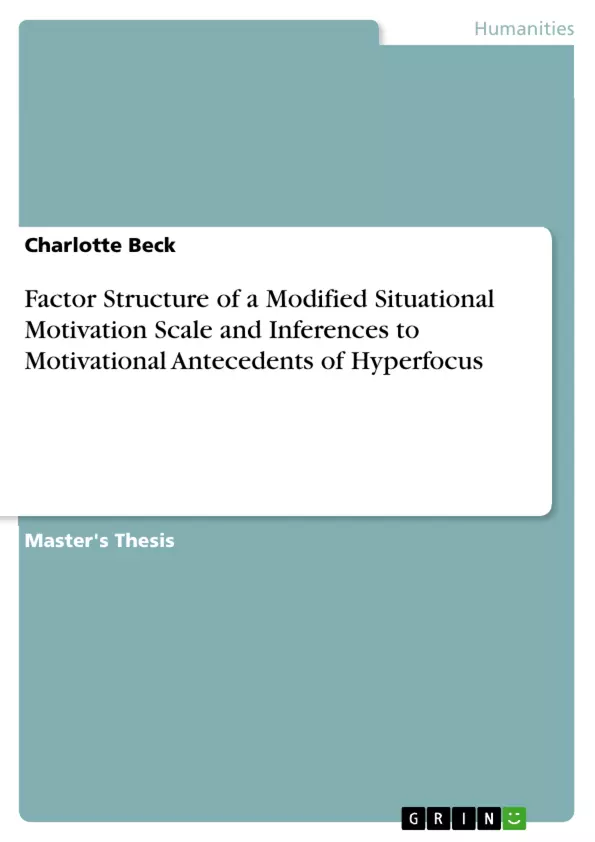Hyperfocus describes a condition of intense concentration on a task, accompanied by a lack of self-, time-, and environment-awareness. To date, only scarce research examined its characteristics and determinants. Hyperfocus appears to lie on the deep side of the flow continuum. Since flow involves intrinsic motivation, it was hypothesized that intrinsic motivation predicts hyperfocus. A modified version of the Situational Motivation Scale (mSIMS) was applied to measure potential motivational predictors of hyperfocus, consisting of adapted and newly created items measuring motivation in line with self-determination theory and task demands, respectively. Predominantly healthy students and working students (n = 331) filled out the questionnaire online. The motivational impact on hyperfocus was analyzed using hierarchical multiple linear regression. Exploratory factor analysis on the mSIMS revealed four factors: intrinsic motivation, autonomous extrinsic motivation, controlled extrinsic motivation, and amotivation. The regression model explained 22% of the variance (p<.01) and indicated that amotivation serves as the strongest predictor of hyperfocus in a general population, followed by intrinsic motivation, autonomous extrinsic motivation, and controlled extrinsic motivation. One-way ANOVA revealed task-demands to have a higher effect on hyperfocus than medium or low task-demands.
The present study is the first to show that hyperfocus can occur without being linked to motivational variables afterward. Thus, hyperfocus seems not to be purely predicted by intrinsic motivation. However, due to the novelty of the findings, future research attempts should replicate the current research and critically analyze potential confounds such as age or diagnostic status.
Table of Contents
- Factor Structure of a Modified Situational Motivation Scale and Inferences to Motivational Antecedents of Hyperfocus
- Hyperfocus and Flow
- Measuring Hyperfocus
- Hyperfocus and Motivation
- Present Research
- Methods
- Participants
- Measures
- Procedure
- Statistical and Data Analysis
- Results
- Exploratory Factor Analysis on the mSIMS
- Hierarchical Multiple Regression
- Exploratory Research
- Discussion
- Main Findings
- Implications, Limitations, and Future Research
- Conclusion
Objectives and Key Themes
The study aims to explore the concept of hyperfocus and its relationship to motivational factors. It seeks to examine hyperfocus outside the context of specific conditions and to investigate potential motivational antecedents. The research uses a modified version of the Situational Motivation Scale (mSIMS) to measure different aspects of motivation. This approach helps identify how different motivational factors, including intrinsic motivation, autonomous extrinsic motivation, controlled extrinsic motivation, and amotivation, are associated with hyperfocus.
- The concept of hyperfocus and its lack of a consensual definition in scientific literature.
- The relationship between hyperfocus and flow.
- The role of motivation in the development and experience of hyperfocus.
- The factor structure of a modified Situational Motivation Scale (mSIMS) and its implications for measuring motivational antecedents of hyperfocus.
- The influence of task demands on hyperfocus.
Chapter Summaries
- Factor Structure of a Modified Situational Motivation Scale and Inferences to Motivational Antecedents of Hyperfocus: This chapter introduces the concept of hyperfocus, its potential relationship to ADHD, schizophrenia, and autism, and its relevance to the current research. It outlines the study's objectives, including examining hyperfocus outside of specific conditions and investigating its potential motivational underpinnings.
- Methods: This section details the research methodology, including participant recruitment, measures used, and the data analysis procedures. The chapter describes the modified Situational Motivation Scale (mSIMS) and its relevance to the study.
- Results: This chapter presents the findings of the study. It focuses on the factor analysis of the mSIMS, revealing four factors: intrinsic motivation, autonomous extrinsic motivation, controlled extrinsic motivation, and amotivation. The chapter also presents results of the hierarchical multiple regression analysis, indicating that amotivation is the strongest predictor of hyperfocus, followed by intrinsic motivation, autonomous extrinsic motivation, and controlled extrinsic motivation.
Keywords
The main keywords and focus topics of the thesis revolve around the concept of hyperfocus, its potential association with specific conditions like ADHD, schizophrenia, and autism, and its connection to motivation. The research is based on self-determination theory and investigates the role of intrinsic motivation, autonomous extrinsic motivation, controlled extrinsic motivation, and amotivation in predicting hyperfocus. The study utilizes the Situational Motivation Scale (mSIMS) as a key tool to measure these motivational factors.
- Quote paper
- Charlotte Beck (Author), 2021, Factor Structure of a Modified Situational Motivation Scale and Inferences to Motivational Antecedents of Hyperfocus, Munich, GRIN Verlag, https://www.grin.com/document/1323676



